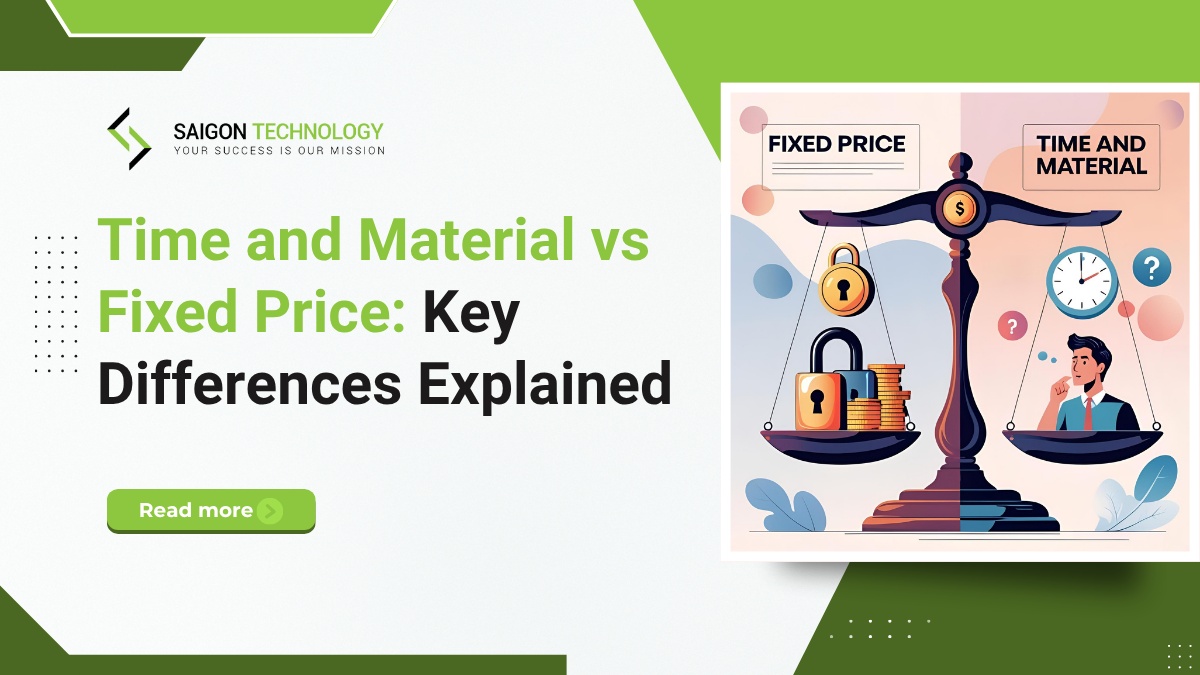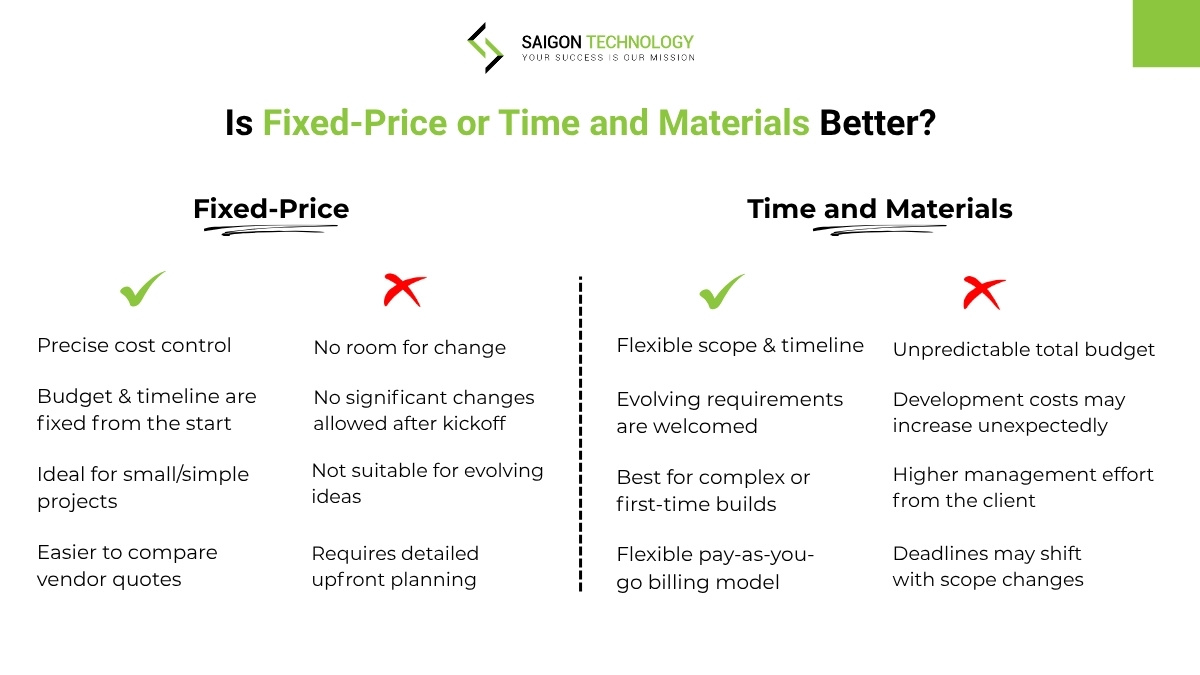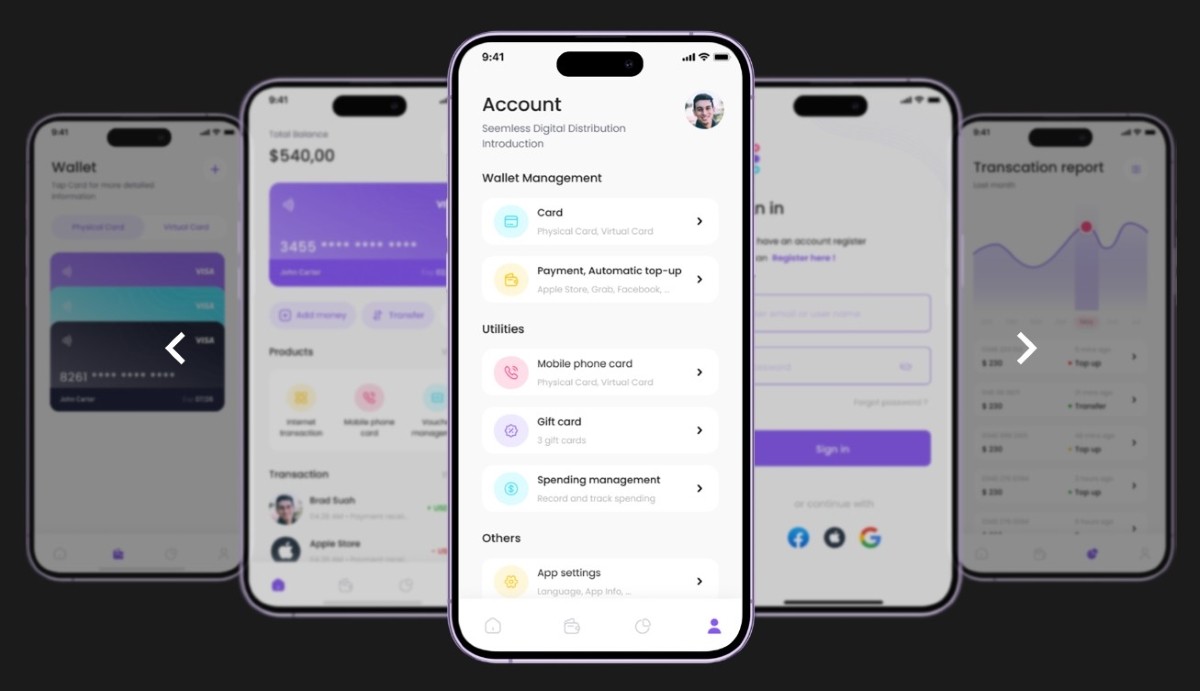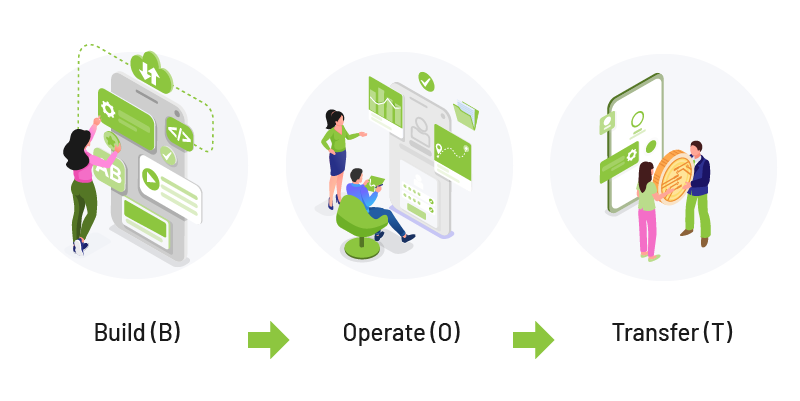Choosing the wrong pricing model can mess up your project. It could cost more, take longer, and end up with lower quality than you wanted. Many businesses are still unclear about the real differences between Time and Material vs Fixed Price models. At Saigon Technology, we assist clients in finding the right pricing method from the start, as the right model is crucial to keeping your project on schedule, within budget, and of high quality.
Time and Materials vs. Fixed Price: A Detailed Comparison
T&M vs Fixed Price contracts are two common approaches in outsourcing software development, each with distinct advantages. Time and Material lets you stay flexible and work together as the project grows. While Fixed Price means you know the cost and plan from the start. Understanding these helps businesses choose what fits their goals and budget. Let’s look at each one to understand it better.
| Criteria | Time and Materials | Fixed Price |
| Scope Flexibility | Great for changing projects. The scope can adjust over time based on feedback or new insights. | Best for well-defined projects where requirements are not supposed to change. |
| Payment Structure | Payment is based on actual time spent and resources used, providing full cost transparency. | You agree on a total cost upfront, regardless of how much time or effort it takes. |
| Client Involvement | Requires active and continuous collaboration. Ideal for agile teams and flexible development. | Minimal involvement needed after the initial planning stage. |
| Quality Control | Allows ongoing improvements during development, based on feedback and testing. | Relies on the accuracy of the initial scope and planning. |
| Managing the Budget | Budget can vary. You need to monitor progress and spending closely. | Budget is fixed, so you have full cost predictability. |
| Project Complexity | Ideal for complex, research-heavy, or innovative projects with evolving needs. | Best for simple, repeatable projects like static websites. |
| Start Speed | Faster to start with minimal planning — suitable for MVPs or urgent tasks. | Slower to start due to the need for detailed specifications and planning. |
What’s a Time and Materials (T&M) Contract?
The time and material meaning refers to a contract model where clients pay for the actual hours worked and the resources used throughout the project. It’s flexible, making it great when project plans might change continuously.
Costs in a T&M model are based on hourly payment, the materials used, and progress tied to interim deadlines. According to the U.S. Government Accountability Office, around 11% of contracts between 2017 and 2021 used the Time and Materials (T&M) model.
This approach works well for projects where both sides require frequent communication and feedback. It makes it easier to make changes as the work moves along.
Why Choose Time and Material Contracts
Time and Material contracts are a good choice for projects that change quickly. They’re flexible, which helps a lot when the details aren’t clear at the start or may change over time. Here’s why this model works well:
- Easy to change plans without big contract updates.
- Keeps everyone involved on track with regular updates.
- Works well for fast-moving projects, allowing quick improvements and faster delivery.
- Shows exactly what you’re paying for with clear reports.
- Helps manage costs for long or experimental projects.
- Less paperwork since the contract doesn’t need constant changes.
- Handles risks better by letting you shift focus if new needs or market changes pop up.
Challenges of the Contract
Time and Material contracts are flexible, but they’re not always the right fit for every project. If you need a fixed budget or a clear timeline, this model can be tricky. Here are some challenges to think about:
- Costs can increase if the project changes requirements or takes an extended period of time.
- Project completion dates may be delayed based on scope changes.
- Clients need to give feedback often for it to work well.
- Require tracking time and materials closely.
Risk Management
The project can change over time, so it’s important to manage risks. Effective approaches are:
- To set a clear budget plan or cost limit
- Regular check-ins and progress updates help identify issues early
- The use of short planning cycles makes sure the team is always focused
- When everyone communicates clearly and works together to stay on track
How Time and Materials Contracts Work in Practice
How Time and Materials contracts work:
- The client and team need to work closely together and make changes if needed.
- Unlike fixed-price contracts, you’re not locked into the plan, so it’s easier to adjust.
- The team tracks their hours and costs and shares updates to keep everything clear and every stakeholder aligned.
- The project moves forward with better control.
Real-world applications and practical considerations:
- Easier to handle changing requirements, especially when the path isn’t clear
- Encourage client involvement
- Support flexible planning
- The ability to adjust priorities as needed
What Exactly is the Fixed Price Contract?
A fixed price contract means the total cost, work to be done, and deadlines are all agreed upon at the start. It’s great for projects with clear plans, giving predictability and less financial risk. You know the cost and deadlines upfront, with payments tied to key steps.
Why Choose A Fixed Price Contract
Contracts with Fixed Price Model provide both pricing certainty and financial predictability. By removing cost surprises and bringing expectations, this model creates a solid basis for both clients and vendors. The main benefits are listed below:
- Clients will know exactly the total cost of the project.
- Predict profits and use resources more efficiently.
- Clear plans mean less need for ongoing talks.
- Teams can work faster with fewer changes to approve.
- Easy to track progress against setting goals.
- Simple to set up rewards or penalties for hitting or missing targets.
Challenges of the Contract
While fixed-price contracts offer a clear structure and keep project staying on budget, they’re not always the best choice for every project. Here are a few common drawbacks:
- Fixed-price contracts make changes can be harder. Adjusting to unexpected changes may take time and cost more.
- Vendors often add extra costs to cover any surprise risks later. That means the initial price might be more expensive than expected.
- With strict deadlines and budgets, development teams might rush to finish or avoid trying new ideas. That can affect the quality of final outcome.
Risk Management
Effective risk management begins with a clear plan including:
- Detailed documentation
- A realistic budget
- A defined scope
But even if it had been carefully planned, there could be something still goes off track. Changes might occur, estimates could be off, or there may be miscommunication. To stay ahead of these issues, the team should:
- Include a little extra time as a buffe
- Backup plan on how to handle any change
- Conduct additional discussions with vendors
How Fixed-Price Contracts Work in Practice
In real-world applications, this pricing model is a good option for some projects like
- App cloning
- Website redesigns
- Building specific features that have clear objectives and strict deadlines
Both clients and vendors will be aware of the project scope and the final price beforehand. And the project requires stakeholders to carefully plan timelines, deliverables, and budget. Usually, payments are linked to significant milestones.
This model, however, works best when the plan remains unchanged. One of the practical considerations is that any changes during the development process may result in delays or require new contracts.
Choosing Fixed-Price or Time and Materials: Which Is Best?
Every model has advantages and knowing when to apply them will help you position your project for success. These factors will influence your decision between time and materials vs fixed fee:
- The project’s objectives
- Financial constraints
- How well the scope is defined
The following questions will help you make a decision easier:
Is the project scope clear and stable?
If yes, a fixed price contract works best. If the scope is likely to change, a T&M contract gives you the flexibility to adapt as you go.
Can you take more time to plan, or do you have to get started right away?
A T&M contract allows you to begin sooner, with minimal documentation. In contrast, fixed price projects require thorough planning before development begins.
Will you or your team be actively involved during development?
If you can provide frequent feedback and make decisions during the process, T&M is a great fit. A fixed price is better if you would rather take a hands-off approach after planning.
Do you require tight cost control, or is your budget flexible?
If you require a strict budget, go with a fixed price. T&M provides greater responsiveness and transparency if you would rather adjust costs during the development process.
A hybrid or mixed model that combines the advantages of both models might be useful if you’re not sure. To define your goals and scope, begin with a fixed-price discovery phase. Then, for flexibility, transition into a T&M development phase. To better manage risks, you can also include tools like:
- Buffer time
- “Not-to-Exceed” clauses
- Backup plans
Conclusion
A fixed price contract offers predictability and clear deliverables. In contrast, the time and materials model allows greater adaptability and collaboration. At Saigon Technology, we often recommend a hybrid approach. The core is to choose between a time-and-materials model and a fixed-price model that actually fits the unique objectives and the room for innovation in your project. Suppose you’re unsure which model is best suited for your business. In that case, we invite you to explore how the fixed price model compares with our engagement model, designed to bring both structure and flexibility to your software development journey.












